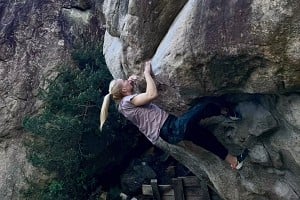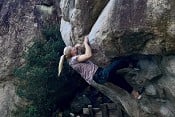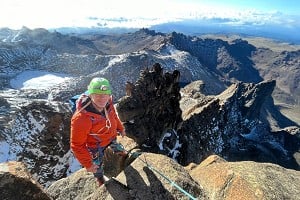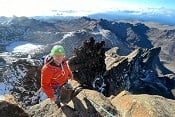
This topic has been archived, and won't accept reply postings.
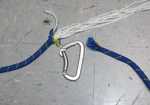 22 September, Mario Luginbühl and a friend went climbing at Magletsch, in the St.Gallen canton, Switzerland. Mario was trying to work out a sequence and took a controlled fall. This proved fatal as the fixed quickdraw had been worn sharp through extensive use and cut the rope right off, resulting...
22 September, Mario Luginbühl and a friend went climbing at Magletsch, in the St.Gallen canton, Switzerland. Mario was trying to work out a sequence and took a controlled fall. This proved fatal as the fixed quickdraw had been worn sharp through extensive use and cut the rope right off, resulting...Read more at http://www.ukclimbing.com/news/item.php?id=67521
In reply to UKC News:
Scarey stuff, and very sad. I've seen several gates like this over the years so I guess I've been lucky. Worth also noting that this is very common at lower offs and although it's rare to climb above a lower off I can think of a few occasions when I have, e.g. to check out the start of a second pitch that also has a first pitch that gets climbed on its own. Whether the wearing is the same I don't know but probably best to avoid.
Scarey stuff, and very sad. I've seen several gates like this over the years so I guess I've been lucky. Worth also noting that this is very common at lower offs and although it's rare to climb above a lower off I can think of a few occasions when I have, e.g. to check out the start of a second pitch that also has a first pitch that gets climbed on its own. Whether the wearing is the same I don't know but probably best to avoid.
In reply to UKC News: The same situation was in the 2008 in the gym at Prague, see http://www.horyinfo.cz/view.php?cisloclanku=2008040001 but without a fatal result.
In reply to Matt Vigg:
I don't think it's the same. The wear on this krab was caused by the ropes wearing only one side, creating a very sharp edge. On lower-off krabs, the rope is rubbing on both sides, so it shouldn't quite cause such a knife edge.
Still.... scary stuff! :-s
I don't think it's the same. The wear on this krab was caused by the ropes wearing only one side, creating a very sharp edge. On lower-off krabs, the rope is rubbing on both sides, so it shouldn't quite cause such a knife edge.
Still.... scary stuff! :-s
In reply to UKC News:
Sad and shocking news. I can't really get my head round exactly what has happened here (as if we don't have enough to worry about) but it is interesting that in both examples the sheath has been cleanly cut but the core appears to have been stripped.
Chris
Sad and shocking news. I can't really get my head round exactly what has happened here (as if we don't have enough to worry about) but it is interesting that in both examples the sheath has been cleanly cut but the core appears to have been stripped.
Chris
In reply to Chris Craggs:
The key is that it isn't fallen on generally. This means that, if you think about the krab hanging, the only wear it ever gets is from a rope going in from the back of the krab and out through it, so the side of the krab that's against the rock gets all the wear, and eventually that creates an edge. It's like a slower version of taking a file, putting it through the krab, and running it across the krab at an angle of say 20 degrees from the angle of the spine of the krab.
The key is that it isn't fallen on generally. This means that, if you think about the krab hanging, the only wear it ever gets is from a rope going in from the back of the krab and out through it, so the side of the krab that's against the rock gets all the wear, and eventually that creates an edge. It's like a slower version of taking a file, putting it through the krab, and running it across the krab at an angle of say 20 degrees from the angle of the spine of the krab.
In reply to AJM:
Side away from the rock presumably?
The wear was from people lowering then. This would wear the krab but can't see it generating a sharp edge, just a sharper angle, it looks around 90 degrees in the photo. In the example in the gym, the wear appears to have almost met the strengthening rib on the krab and created a sharp edge mind.
Chris
Side away from the rock presumably?
The wear was from people lowering then. This would wear the krab but can't see it generating a sharp edge, just a sharper angle, it looks around 90 degrees in the photo. In the example in the gym, the wear appears to have almost met the strengthening rib on the krab and created a sharp edge mind.
Chris
In reply to Chris Craggs:
It's not the same wear pattern that you get on say a fixed belay krab, where basically the rope runs vertically up, through the krab then vertically down. It's where you have a fixed krab/quickdraw that spends its life with the rope running through the krab at a slight but fixed angle. This is likely to happen to fixed draws on steep/overhanging rock, but in a part of the route that is easy or straightforward and so doesn't get fallen on... until it does. On the basis of this and after inspecting my old lightweight quickdraws that I've used almost exclusively on steep sport routes, I'm retiring them!
It's not the same wear pattern that you get on say a fixed belay krab, where basically the rope runs vertically up, through the krab then vertically down. It's where you have a fixed krab/quickdraw that spends its life with the rope running through the krab at a slight but fixed angle. This is likely to happen to fixed draws on steep/overhanging rock, but in a part of the route that is easy or straightforward and so doesn't get fallen on... until it does. On the basis of this and after inspecting my old lightweight quickdraws that I've used almost exclusively on steep sport routes, I'm retiring them!
In reply to Chris Craggs:
No - the side against the rock. Nobody ever lowered off on the krab, it had a loaded rope pressed against one side of it for its entire life as people lowered off or fell onto higher bolts, but never the other side, hence a very uneven wear pattern.
No - the side against the rock. Nobody ever lowered off on the krab, it had a loaded rope pressed against one side of it for its entire life as people lowered off or fell onto higher bolts, but never the other side, hence a very uneven wear pattern.
In reply to AJM:
I can't visualise that, but not to worry, I certainly get the idea. Interestingly that photo used in the gym photo is actually a BD test photo.
Chris
I can't visualise that, but not to worry, I certainly get the idea. Interestingly that photo used in the gym photo is actually a BD test photo.
Chris
In reply to Chris Craggs:
One point worth noting is that the illustration on the UKC article isn't the actual carabiner and rope from the incident in the article. It seems to come from one of Black Diamond's regular gear blog posts - http://www.blackdiamondequipment.com/en-us/journal/climb//qc-lab-dangers-of... (always very interesting, by the way, for those that aren't already aware of them). It's not from an actual incident at all, but the result of a lab test. Black Diamond don't make it entirely clear where the carabiner in the picture came from but in an earlier test of the same issue they were using carabiners that got worn from use as fixed draws at sport crags, I presume the same is true.
I do think it would be worthwhile for UKC to make the origin of the image more clear, it does seem reasonable to assume, unless otherwise stated, that a picture accompanying a news item is of the actual incident in question.
One point worth noting is that the illustration on the UKC article isn't the actual carabiner and rope from the incident in the article. It seems to come from one of Black Diamond's regular gear blog posts - http://www.blackdiamondequipment.com/en-us/journal/climb//qc-lab-dangers-of... (always very interesting, by the way, for those that aren't already aware of them). It's not from an actual incident at all, but the result of a lab test. Black Diamond don't make it entirely clear where the carabiner in the picture came from but in an earlier test of the same issue they were using carabiners that got worn from use as fixed draws at sport crags, I presume the same is true.
I do think it would be worthwhile for UKC to make the origin of the image more clear, it does seem reasonable to assume, unless otherwise stated, that a picture accompanying a news item is of the actual incident in question.
In reply to Chris Craggs:
Eight out of twelve of my quickdraws look like this: http://www.ukclimbing.com/images/dbpage.php?id=206757 I've just binned them. Needed some retail therapy anyway...!
> the wear appears to have almost met the strengthening rib on the krab and created a sharp edge mind.
Eight out of twelve of my quickdraws look like this: http://www.ukclimbing.com/images/dbpage.php?id=206757 I've just binned them. Needed some retail therapy anyway...!
In reply to UKC News:
Am I right that the wear occured due to the fixed krab being repeatedly pulled against the rock? Or had the krab been fallen on in the past while clipped to a bolt somewhere else?
If the former then I can't see how this (the wearing and the fatal fall ) could occur except in the rarest of rare circumstances and therefore isn't really something for folk to look out for. Is it not quite rare to have fixed quickdraws on an outdoor route, particularly a section of the route that folk rarely fall off? Of course there is potential for krab wear at an abseil point but this is different to a situation where the krab is rarely weighted.
The wear folk on here have on their quickdraws is surely not gradual wear from the rock but is caused by them falling on bolts? That's why if you sport climb regularly you never use the same krab for the bolts and the rope.
Am I right that the wear occured due to the fixed krab being repeatedly pulled against the rock? Or had the krab been fallen on in the past while clipped to a bolt somewhere else?
If the former then I can't see how this (the wearing and the fatal fall ) could occur except in the rarest of rare circumstances and therefore isn't really something for folk to look out for. Is it not quite rare to have fixed quickdraws on an outdoor route, particularly a section of the route that folk rarely fall off? Of course there is potential for krab wear at an abseil point but this is different to a situation where the krab is rarely weighted.
The wear folk on here have on their quickdraws is surely not gradual wear from the rock but is caused by them falling on bolts? That's why if you sport climb regularly you never use the same krab for the bolts and the rope.
In reply to Michael Gordon: The mechanism for wear in the photos is from the rope repeatedly rubbing over the carabiner hundreds if not thousands of times. This can be speeded up by dirt and grit on the rope.
In reply to chris, the lab cut rope sheath looks like it has not been cut squarely across but at an angle. Could it be possible that as the rope moves over the edge it will expose each of the weaves of the sheath to cutting stripping it then leaving the core vulnerable also.
In reply to chris, the lab cut rope sheath looks like it has not been cut squarely across but at an angle. Could it be possible that as the rope moves over the edge it will expose each of the weaves of the sheath to cutting stripping it then leaving the core vulnerable also.
In reply to Michael Gordon:
It's wear caused by movement of a rope being pulled through the krab, made worse by this happening at a fairly constant angle and generally in only one direction. This cuts a semicircular groove into the rope holding surface of the krab, leaving a sharp edge. This sharp edge then cuts the rope in a fall.
Essentially, a problem that may occur with fixed draws both at crags and at climbing walls (but walls will inspect their fittings regularly).
It's wear caused by movement of a rope being pulled through the krab, made worse by this happening at a fairly constant angle and generally in only one direction. This cuts a semicircular groove into the rope holding surface of the krab, leaving a sharp edge. This sharp edge then cuts the rope in a fall.
Essentially, a problem that may occur with fixed draws both at crags and at climbing walls (but walls will inspect their fittings regularly).
In reply to Michael Gordon: This is all about ROPE wear, on the rope end krab of the quickdraw.
And, no, in some places it's not rare to have QDs left in place. In some areas its the norm, particularly on steep routes that are hard to strip.
And, no, in some places it's not rare to have QDs left in place. In some areas its the norm, particularly on steep routes that are hard to strip.
In reply to Dan Middleton, BMC:
Presumably it only really happens where there is significant change of rope angle at the quickdraw otherwise there would be no significant friction. It wouldn't happen on a straight up route, would it ?
Presumably it only really happens where there is significant change of rope angle at the quickdraw otherwise there would be no significant friction. It wouldn't happen on a straight up route, would it ?
In reply to above:
Ah ok, cheers. You learn something new every day. I'd never have thought this could happen just from the rope.
I still think this is a very rare set of circumstances.
Just checked my quickdraws and there's pretty much no wear at all on the krabs despite plenty use over many years.
Ah ok, cheers. You learn something new every day. I'd never have thought this could happen just from the rope.
I still think this is a very rare set of circumstances.
Just checked my quickdraws and there's pretty much no wear at all on the krabs despite plenty use over many years.
In reply to GrahamD:
A groove could be formed just by repeated falls and pulling the rope through a krab. But that is of course different to what happened in this case.
A groove could be formed just by repeated falls and pulling the rope through a krab. But that is of course different to what happened in this case.
In reply to Michael Gordon:
Yes, I was thinking more of the case where the krab effectively gets chamferred. Very unlucky
Yes, I was thinking more of the case where the krab effectively gets chamferred. Very unlucky
In reply to Michael Gordon: Sport climbing though? See Jon's new photos - he's chucking out a bunch of krabs having given them a good look.
In reply to jon:
Scary! What kind of use have these had?
> Eight out of twelve of my quickdraws look like this: http://www.ukclimbing.com/images/dbpage.php?id=206757 I've just binned them. Needed some retail therapy anyway...!
Scary! What kind of use have these had?
In reply to TobyA:
Yes I saw those. Maybe Jon can clarify but I'd assumed the wear on those krabs was from falling onto bolts. For the rope to do that alone I think the krab would have to be in-situ on a crag and used by lots of people every day.
Yes I saw those. Maybe Jon can clarify but I'd assumed the wear on those krabs was from falling onto bolts. For the rope to do that alone I think the krab would have to be in-situ on a crag and used by lots of people every day.
In reply to Jimbo W:
Well very intense use, actually. They are Wild Country's first generation (I think) wire gates and are quite old now, but are so light and nice to use, they've been used for maybe 90% of my climbing which has been nearly all steep sport climbing. This is the point really, this sort of wear can't really occur on less than vertical routes. Also, I think standing out from the crag when lowering someone off can contribute enormously to the problem. To be honest, I noticed the wear some months ago, but sort of ignored it. This thread has made me think again.
Well very intense use, actually. They are Wild Country's first generation (I think) wire gates and are quite old now, but are so light and nice to use, they've been used for maybe 90% of my climbing which has been nearly all steep sport climbing. This is the point really, this sort of wear can't really occur on less than vertical routes. Also, I think standing out from the crag when lowering someone off can contribute enormously to the problem. To be honest, I noticed the wear some months ago, but sort of ignored it. This thread has made me think again.
In reply to Michael Gordon:
Michael, see my post above. Also have a look at the photos in the link that jandik post some way above: http://www.horyinfo.cz/view.php?cisloclanku=2008040001 They illustrate really well the way the krabs have been worn. Mine have never been in situ (more than a day, anyway) - I just climb a lot.
Michael, see my post above. Also have a look at the photos in the link that jandik post some way above: http://www.horyinfo.cz/view.php?cisloclanku=2008040001 They illustrate really well the way the krabs have been worn. Mine have never been in situ (more than a day, anyway) - I just climb a lot.
In reply to jon:
Thanks Jon, this is all very interesting to me! Have the krabs you use on the bolts got a different pattern of wear, i.e. bumpy, less of a smooth groove? I assume those ones get worn quicker also.
Thanks Jon, this is all very interesting to me! Have the krabs you use on the bolts got a different pattern of wear, i.e. bumpy, less of a smooth groove? I assume those ones get worn quicker also.
In reply to Michael Gordon: No that makes a totally different type of mark - much more messy. Look at the photo in this old review: http://www.ukclimbing.com/gear/review.php?id=1140 those gouges were from just a few light falls onto old style petzl hangers. Looks very different from rope wear. Belay krabs get similar smooth wear from rope. This was a newish krab, I think I had used it mainly for ice climbing (clean, less abrasion from dust/more lubrication from melting snow) for a few months - http://twitpic.com/9h9far My older HMS have deeper wear marks from years of use.
In reply to Michael Gordon:
Yes, the bolt end krabs have a sharp groove worn in them. It's very easy to tell which end is which. They look completely different.
Yes, the bolt end krabs have a sharp groove worn in them. It's very easy to tell which end is which. They look completely different.
In reply to TobyA:
Time to wheel this one out again, Toby: http://www.ukclimbing.com/images/dbpage.php?id=115364 That's twice in a week!
Time to wheel this one out again, Toby: http://www.ukclimbing.com/images/dbpage.php?id=115364 That's twice in a week!
In reply to Michael Gordon:
I was hoping I had a photo of a quickdraw I took off a route in northern Greece but can't find it - it had been on the crux of an often fallen off route in a steep cave and the petzl bolt had worn about half way through the top gate in a pretty clean way, never seen one like it before or since. I gave it to DMM to test and it broke at or above what it was rated for.
I was hoping I had a photo of a quickdraw I took off a route in northern Greece but can't find it - it had been on the crux of an often fallen off route in a steep cave and the petzl bolt had worn about half way through the top gate in a pretty clean way, never seen one like it before or since. I gave it to DMM to test and it broke at or above what it was rated for.
In reply to Matt Vigg: Yep, I gather from DMM the main issue with rope wear into karabiners is generally not loss of strength to the biner. In some cases they even end up breaking at higher strengths than orginally rated (weird as that might seem) as the worn "groove" keeps the rope/ sling located right next to the spine and helps prevent the nose of the biner levering open under extreme load. The problem (as highlighted here) is that same wear pattern can cause damage / failure of the rope itself.
This topic has been archived, and won't accept reply postings.
Loading Notifications...



